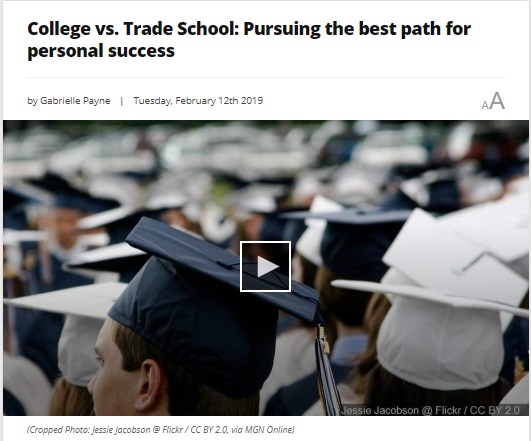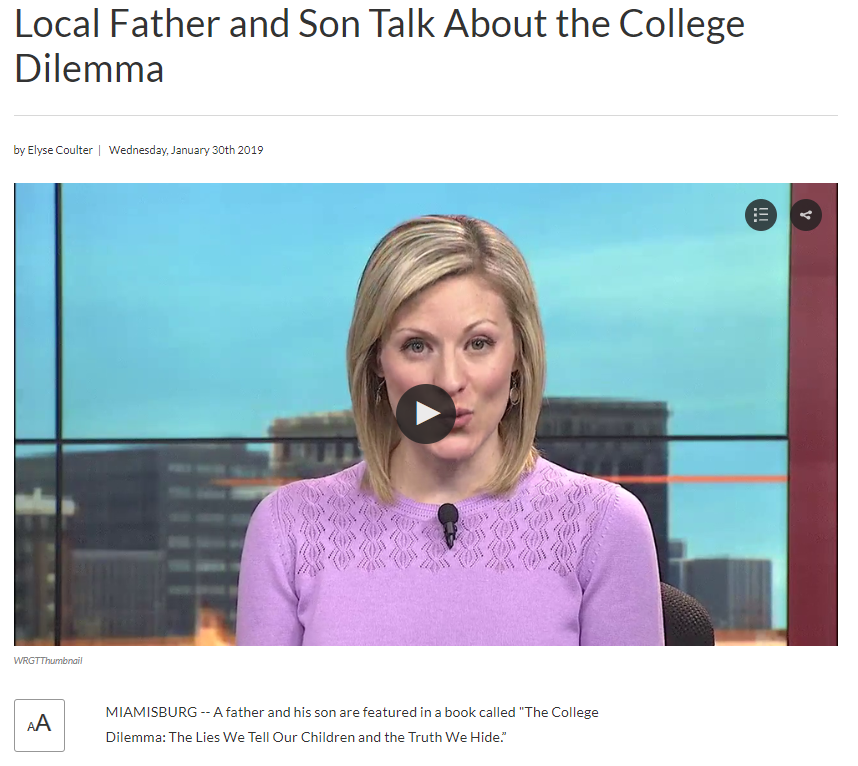The tool we use to evaluate the decision to go to college is called ROI, or Return on Investment.
All students at this point need to do some basic math. What is the ROI of going to college? And does it make sense?
ROI is fairly basic- it is simply “Is what I get from something, worth what I put into it plus the lost opportunity cost”. Many people fail to consider the “lost opportunity cost”. For example, does it make sense to drive across town to save 1 cent per gallon on gas. Typically no- While you gain 18 cents in an 18 gallon tank, you lose 60 cents in gas used driving plus 15 minutes of your life that could be used doing other things.
Therefore when going to college you have these three factors:
-What College Costs (Direct Costs)
-What Opportunity is forgone (Indirect Costs)
-What the benefit is (return)
ROI = Return / (Direct Costs + Indirect Costs)
An “ROI” of 1 means that there is no gain from the investment. Some people like to calculate risk premium as part of the ROI calculation, but I find risk premiums too arbitrary and they are weighted too heavily for how arbitrary they are. If I have an ROI of 1, or no gain, but I have a risk of actually achieving the stated return, it does not seem worthwhile to partake.
An ROI below 1 means that there is actually loss from the investment. In these cases, taking the investment actually loses money. Why would someone ever take an investment that loses money? If that’s the case, it isn’t an “investment at all”. The only time to take an opportunity with a negative ROI, or an ROI below 1, is if its to pursue your dreams and goals.
An ROI above 1 means there is a positive gain from the investment. In these cases, the investment does have a positive return, and therefore should be pursued. The one exception is that if there is another opportunity with a higher ROI, in which case the better opportunity should be pursued.
Lets discuss some of the components of this calculation:
Return- What is the real return of your investment? This can be quite tricky. You see, where can you get data you trust?
Many students state they are expecting large salaries because their school program told them that graduates in a certain field have a certain salary. However, schools intend to maximize the amount of money they make. They spend money marketing their programs to get students. They are not an unbiased third party! I’ve even sat on boards at schools promising salaries that make me scoff- knowing all too well that the stated salary is not realistic. Salaries for different fields vary by location, and job types, not by degree held. A project manager in Silicon Valley may make $125,000- But I personally know a college-degree-holding project manager with 10 years of experience that’s making about $45,000 in Cincinnati Ohio.
So what return can you expect? First off all, going to college for a specific “degree” is not why you are there. There are people who have engineering degrees but decide they want to teach highschool, and people with education degrees that use it to be a recruiter. You are going to college for a career, and therefore you should be looking at salaries for your careers of interest for this exercise. Ultimately you should be choosing the majors that put you in the best position for your career interests, and therefore keep the end in mind.
When looking for the return for a specific job, you can ask people. Many won’t disclose, and for those who do, assume everyone will overstate their salary. Also take into consideration their age, as someone in the field for 30 years likely makes a lot more than someone in the field for months.
When someone asks how much I make I scoff. Not only is that a rude question, but would anyone expect anyone else to answer that honestly? That’s something people always seem to over state. Glassdoor.com is actually helpful, but they are just estimates. People tend to say, “look I can make up to $62,000” in that job forgetting the fact that students right out of college are at the low end of that “32,000-62,000” range. I’ve worked with a few college students who actually go years unemployed because they can’t find a job that “pays what I’m worth”. Newsflash: If you can’t find a job that pays what you are worth, you aren’t worth as much as you think you are.
Is it realistic for a college graduate to get paid in the 30s? Why yes, I’d say that isn’t just realistic, but more common than most would like to admit. Despite the fact that many college graduates insist they want $75,000 a year out of school, In fact I find college students with salaries in the 20’s more than I find college graduates with salaries in the 50s or more. Sure it depends on location and specific career fields, but remember, “Everyone thinks they deserve to be at the top of the salary range”.
You can also ask companies what the salary is for a specific job, and look at job postings. You may find enough examples that state it in the listings or will tell you on the phone to create a good expected return, but remember to be realistic. Don’t go look at “SR ENGINEER LEVEL V” and think, “That’s what I’m going to do when I graduate”. Presume you’re going to be “JR ENGINEER LEVEL 0” instead- you’ll be lucky to get an engineering job at all.
To put this into perspective for our ROI, Let’s say for example, you finished in the middle of your class, and you’re a pretty average person. You decide you should go to college so you can get a good job, and you decide that you’ll get a History degree, because history interests you. Like many liberal arts degrees, while they like to think of themselves as someone who can “do anything”, it can equally be said they become the “Jack of all Trades, Master of None”. So you use your newfound degree to become a Librarian.
Your librarian salary isn’t too bad, and you sport $38,000 out of school and eventually rise to 48,727. Late in your career you can expect to rise up to about $59,000. Certainly not a bad job, and it sounds good for many students.
The actual return though doesn’t include the fraction you’d be making at the same time with the job you would have gotten without a degree. In this case we look at your alternative career, a Teachers Aid. Starting at about $9 an hour, you eventually rise to $11 an hour and ultimately end up at $13 an hour. Just like as a librarian, you choose to work through summers to assure you have consistent income.
In this case we’ll use the 3 point estimating method to come up with your salary baseline for both careers:
Librarian: $48,651
Teacher’s Aid: $22,880
The “Return” would be the new salary minus the alternative salary times career length, or:
(COLLEGE SALARY – NON-COLLEGE SALARY)*CAREER LENGTH
It would be very reasonable to consider investment returns from savings strategies here for the Librarian (For example, the returns on the income), but since most people tend to be poor savers either way, for this example we are not.
COLLEGE SALARY – NON-COLLEGE SALARY is also known as “annual lift”
$48,651-$22,880 = $25,771 annual lift
Annual lift * CAREER LENGTH = Return
$25,771 * 41 working years = $1,056,611
The Librarian makes just over 1 million dollars more than the Teacher’s Aid over a 41 year career.
Direct Costs- What is the actual cost of the college degree you are approaching?
The direct costs seem like an easy calculation, but it gets tricky quick, because you not only have to calculate the actual money spent, but all ancillary money spent (room, board, etc.) and the interest amount paid back.
Let’s take for example, the statistics published by CollegeData.com. The actual costs someone has in college includes the actual tuition, books, your room, your food, as well as clothes, toiletries, room items, and entertainment expenses. Most students may be surprised at how much peer pressure there is to spend month on entertainment expenses in school, but savvy students can pass on dinner, concerts, bowling, and beers. CollegeData states that the average tuition and fees cost is $33,480 at private colleges, and $9,650 at in-state colleges (Out of state-state colleges come in at $24,930). Room and board on the other hand comes in at $10,440 for in state colleges up to $11,890 for private schools. Books and school supplies come in at around $1240 for both public and private colleges, plus $2720-3270 for transportation, clothing, personal items, etc. This is the average, which means there are a lot of people above this. It is not a worst-case scenario. This puts the direct cost right around $49,330 a year for private colleges and as cheap as $24,600 for in-state schools.
So if we take this number and multiply it by 4, that will get us a good cost, right?
Not quite. There’s still two pieces missing. First off, despite it being called a “4 year degree”, a bachelors degree typically takes longer. According to the New York Times, only 19 percent of full time students finish that “4 year degree” in 4 years at public universities. What this equates to is an expected 6 year time frame not for a masters degree and bachelors degree, but just a normal bachelors degree.
Over 6 years, this totals $295,980 for Private schools and $147,600 for in-state schools.
Here we still aren’t quite done yet, because a whole lot of students get student loans. Any money paid out of pocket by students or parents needs to be considered as part of the “indirect costs” or “opportunity costs”. Any money not spent directly would come from loans, and therefore the interest paid on the loan is also part of the direct costs. Imagine the parents saved $20,000 to put towards a theoretical student’s loan. That would still mean $20,000 was part of the direct cost, but we only count the interest expense- the amount you have to pay for the loan- for the remaining amount (275,980 or $127,600 respectively)
For this part of the calculation, most students would look at the federal student loan rate of 4.45% for direct unsubsidized or subsidized loans. For this example we’ll assume this 4.45% rate AND subsidized loans, which is “best case scenario”. Many students end up having to get Direct PLUS loans or private loans because they don’t qualify for 100% of their costs through the direct loan programs. Students should calculate what they are really expected to pay, and not just settle for the “best case scenario”, because many, if not most, students have to take higher interest loans.
According the US News, it takes an average of 21 years to pay off a student’s loans. Putting this into perspective, The $275,980 after the parents savings for Private school, over 21 years, equates to $1657 a month for half of a student’s expected working life. This includes the 141,693.73 of interest, making the direct cost $437,674. For the in-state schools, this total drops to only $213,113. Many students opt for spring break trips and other activities. These types of activities need to be added on to the direct costs, including interest (credit card or student loan) if applicable. Forbes magazine reports that 30.6% of students spend loan money on spring break trips, with others use loan money for alcohol, clothes, and even drugs. While I certainly would never advocate the use of loan money for any of these items, anyone choosing to do so needs to include this information – and the interest accumulated from it- into their calculation.




